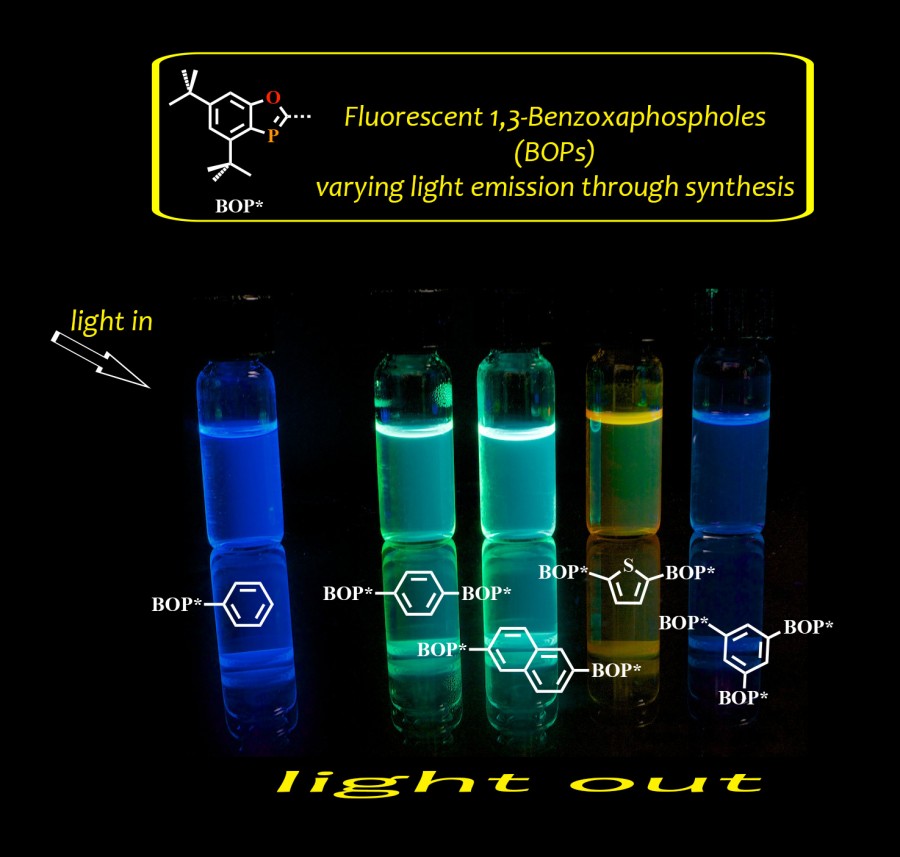[INTRO] Molecules and materials that interact with or generate light have always fascinated people and been explored for useful purposes. Glow-in-the-dark toys introduce many children to the interesting ability of materials to give off light for time after accepting the energy of room light (phosphorescence). Clothing that glows under a black light can change ordinary shirts into extraordinary garments (fluorescence). At sporting events, concerts, trick or treating during Halloween, light sticks are fun examples of how chemical reactions can produce light (chemiluminescence). Sunlight is now being used as a “clean fuel” to create electricity for our energy needs (photovoltaic chemistry). Electricity, long used to generate light from tungsten filaments in the common light bulbs, can also now be used to more efficiently generate light from organic molecules and plastics (OLEDs, organic light emitting diodes). OLEDs and photovoltaics based on organic materials offer the promise of flexible electronic devices.
Common to all of these processes is the fact that excited states of the molecules and materials are involved in light emission and/or absorption. For the synthetic chemist (someone who makes molecules and materials), the design of new molecules and materials that have the correct combination of properties (such as color of absorption, color of light emission, potential at which electrons can be added or removed, cost and ease of preparation and processability, etc.) presents opportunities for development of new materials for study, and perhaps for use in devices of use to the public. Fundamental physical studies of these materials aim to understand the factors that control these properties. Organic chemists have already produced a immense number of conjugated organic polymers that have excited properties. The 2000 Nobel prize was given to three pioneers in this field. In this regard, inorganic chemists are actively dreaming up and crafting new functional motifs that capitalize upon the 100+ elements of the periodic table. [/INTRO]
[Our Research Strategy] We are interested in the construction of conjugated materials that incorporate multiply bonded low coordinate main group elements, in particular, phosphorus. Many fascinating and technologically important polymers having backbones comprised of C=C units in a conjugated fashion, and such materials are being intensely studied for electronic and optical properties in areas such as organic light emitting diodes (OLEDs) and organic solar photovoltaics (PVs). Using the well-known diagonal relationship between carbon and phosphorus, one of our goals is to prepare new materials having having P=C and P=P double bonds along the conjugation pathway. One successful polymer is compared to a model oligomer (right) below (Inorg. Chem. 2003), and a class of new polymers including a diphosphene containing polymer is also shown below ( JACS 2004). Double bonds involving phosphorus (P=C and P=P) are weaker than carbon-carbon double bonds (C=C), yielding smaller HOMO-LUMO gaps and offering new mechanisms for modulating electronic and optical properties of the materials . An added challenge to this work is the need to design new multifunctional ligands for phosphorus that also are sterically encumbered. In addition, we are exploring new modes of synthesis of these materials (such as the “phospha-Wittig” reaction Chem. Commun. 1998, Eur. J. Inorg. Chem. 2012) for rapid construction of P=C bonds in a selective manner.


More recently we have been exploring new types of 1,3-benzoxaphosphole (BOPs, below) as highly luminescent materials (some papers: JACS 2010, Chem. Commun. 2014, Dalton Trans. 2014, Europ. J. Inorg. Chem. 2016). J. Am. Chem. Soc. 2019, RSC Advances 2020, Organometallics 2021)


This work is currently being funded by the National Science Foundation.
[/Our Research Strategy]
Interest Area 1: Inorganic-Organic Hybrid Materials for Optoelectronic & Energy applications
Specific Project (a) Conjugated Materials Featuring Inorganic Elements
Specific Project (b) Designing New Materials for Increased Safety of Lithium Ion Batteries
Interest Area 2. Catalysis involving Main Group & Transition Metal Chemistry
Specific Project (a) Secondary Bonding and Hypervalent Organoiodine(III) Complexes
Specific Project (b) New Ligands for Catalysis based on meta-Terphenyls
